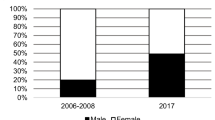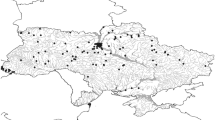Abstract
Spatial and temporal analysis of frequency distribution patterns of the Rana esculenta (= lessonae )- specific allele, Ldh-B 71 , in the populations and individuals of R. ridibunda from the Middle Dnieper region was performed. It was established that the allele was accumulated in the populations of Kiev, where on average 15 to 25% of individuals steadily preserved this allele through at least three to four generations. Furthermore, the allele frequency in juveniles and adults was similar. These findings suggest that the frogs carrying foreign genetic material were not eliminated from the populations, and hence, the observed introduction of foreign genes was adaptively neutral. The transfer of the genetic material from one species to another may be considered as a possible mechanism of the formation of an additional source for population genetic variation, which, however, do not seems to be evolutionary progressive.
Similar content being viewed by others
REFERENCES
R. Günther T. Uzzell L. Berger (1979) Inheritance Patterns in Triploid Rana “esculenta,” Mitt. Zool. Mus. Berlin 55 35–57
T. Uzzell H. Hotz L. Berger (1980) ArticleTitleGenome Exclusion in Gametogenesis by an Interspecific Rana Hybrid: Evidence from Electrophoresis of Individual Oocytes J. Exp. Zool. 214 251–259
S.I. Guttman (1985) ArticleTitleBiochemical Studies in Anuran Evolution Copeia 2 292–309
A.E. Vinogradov L.J. Borkin R. Günther (1990) ArticleTitleGenome Elimination in Diploid and Triploid Rana esculenta Males: Cytological Evidence from DNA Flow Cytometry Genome 33 619–627
R. Günther (1991) ArticleTitleEuropäische Wasserfrösche (Anura, Ranidae) und biologisches Artkonzept Mitt. Zool. Mus. Berlin 67 IssueID1 39–53
S. Morozov-Leonov (1997) Genetic Processes in Hybrid Populations of the Rana esculenta Species Complex from Ukraine Cand. Sci. (Biol.) Dissertation Inst. Zool. Kiev
L. Berger (1976) ArticleTitleIs the Rana esculenta Complex a Simple Hybrid? Ekologiya 2 37–43
G. Abt H.-U. Reyer (1993) ArticleTitleMate Choice and Fitness in a Hybrid Frog: Rana esculenta Females Prefer Rana lessonae Males over Their Own Behav. Ecol. Sociobiol. 32 221–228
R.B. Khesin (1985) Nepostoyanstvo genoma Nauka Moscow
A. Pagano D. Schmeller (1999) Is Recombination Less Negligible Than Previously Described in Hybridogenetic Water Frogs? C. Miaud R. Guyetant (Eds) Current Studies in Herpetology: Proc. 9th Ordinary General Meeting Soc. Europaea Herpetologica France Chambery 351–356
O. Spasic-Boskovic I. Krizmanic M. Vujosevic (1999) ArticleTitlePopulation Composition and Genetic Variation of Water Frogs (Anura, Ranidae) from Yugoslavia Caryologia 52 IssueID1-2 9–20
C. Spolsky T. Uzzell (1986) ArticleTitleEvolutionary History of the Hybridogenetic Hybrid Frog Rana esculenta as Deduced from mtDNA Analyses Mol. Biol. Evol. 3 IssueID1 44–56
S.V. Mezhzherin S. Morozov-Leonov (1997) ArticleTitleGene Introgression in Hybrid Populations of Green Frogs of Rana esculenta L., 1758 Complex (Amphibia, Ranidae) from the Dnieper Basin Russ. J. Genet. 33 IssueID3 285–290
S.V. Mezhzherin S. Morozov-Leonov (1994) ArticleTitleGenetic Defects Arising upon Hereditary Transmission and Genetic Variation of the Ldh-B Locus in Hybrid Populations of Green Frogs of the Rana esculenta Complex (Amphibia, Ranidae) Izv. Akad. Nauk 5 779–787
S.V. Mezhzherin S. Morozov-Leonov (1994) ArticleTitleGenetic Instability upon Hereditary Transmission of Variants of the Ldh-B Locus in Hybrid Matings between Rana esculenta Complex Forms (Amphibia, Ranidae) Dokl. Akad. Nauk 339 IssueID1 140–141
S.V. Mezhzherin V.N. Peskov (1992) ArticleTitleBiochemical Variation and Genetic Differentiation of Populations of Lake Frog Rana ridibunda Rall. Tsitol. Genet. 26 IssueID1 43–48
S.V. Mezhzherin S. Morozov-Leonov (1993) ArticleTitlePopulation Genetic Analysis of the Structure of Hybrid Populations of Green Frogs of the Rana esculenta Complex Tsitol. Genet. 27 IssueID2 63–68
S. Morozov-Leonov S.V. Mezhzherin (1995) ArticleTitleAnalysis of the Genetic Structure of Hybrid Populations of Green Frogs of the Rana esculenta Complex from the Danube Tsitol. Genet. 29 IssueID2 71–75
S.V. Mezhzherin S. Morozov-Leonov (1996) ArticleTitleGenetic Analysis of the Structure of Hybrid Populations of Green Frogs of the Rana esculenta L. Complex (Amphibia, Ranidae) from the Volyn’ Region Tsitol. Genet. 30 IssueID1 48–52
Nekrasova, O.D., Population Structure and Hybridization of Green Frog Rana esculenta Complex from Urban Regions of the North Dnieper, Cand. Sci. (Biol.) Dissertation, Kiiv, Institute of Zoology, 2002.
Author information
Authors and Affiliations
Additional information
Translated from Genetika, Vol. 40, No. 12, 2004, pp. 1646–1653.
Original Russian Text Copyright © 2004 by Mezhzherin, Morozov-Leonov, Nekrasova.
Rights and permissions
About this article
Cite this article
Mezhzherin, S.V., Morozov-Leonov, S.Y. & Nekrasova, O.D. Natural transfer of nuclear genes in hybrid populations of green Frogs Rana esculenta L., 1758 complex: space–time analysis of the phenomenon. Russ J Genet 40, 1364–1370 (2004). https://doi.org/10.1007/s11177-005-0006-z
Received:
Revised:
Issue Date:
DOI: https://doi.org/10.1007/s11177-005-0006-z




